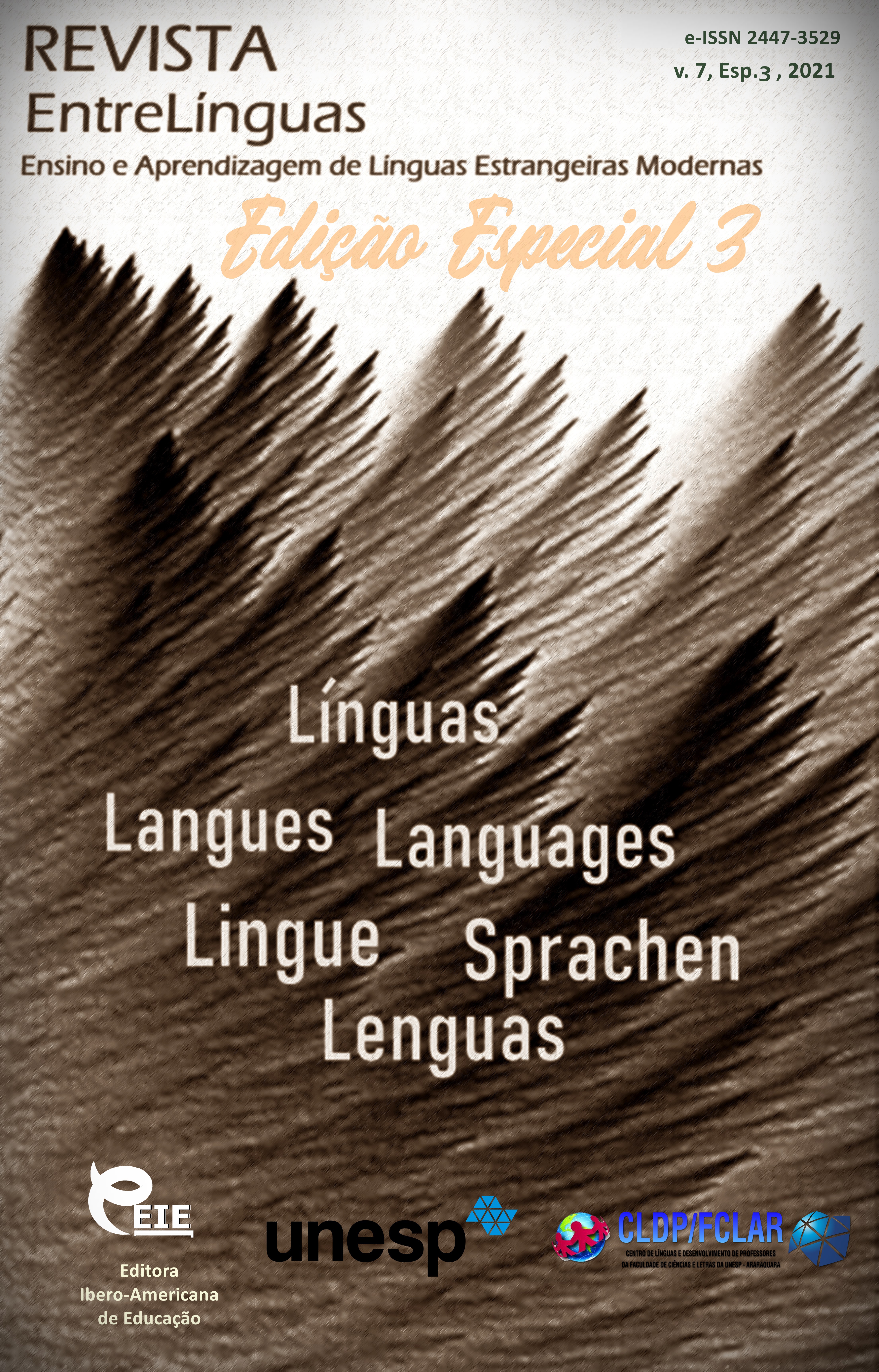Análise estrutural e semântica de alguns termos epônimos de física para contribuir com o ensino e comunicação
DOI:
https://doi.org/10.29051/el.v7iesp.3.15723Palavras-chave:
Linguística, Linguagem, Peculiaridades estruturais e semânticas, Termo epônimoResumo
O rápido desenvolvimento de novas tecnologias e produtos devido a descobertas em todos os campos das ciências, também no campo da Física, leva ao surgimento de termos epônimos. Esse fenômeno requer o estudo e a análise dessas unidades lexicais, pois muitas vezes podem confundir os alunos e também os cientistas ao interpretá-las de forma adequada durante os processos de aprendizagem e comunicação. A relevância do tópico está em considerar algumas peculiaridades linguísticas de epônimos e combinações de termos de epônimos para tentar combinar questões de educação e os resultados do tópico em discussão. Algumas diferenças estruturais e semânticas dos mesmos termos epônimos em ambas as línguas podem causar dificuldades em sua percepção e intertransição. O artigo fornece uma análise comparativa, processamento, generalização e sistematização de algumas peculiaridades estruturais e semânticas dos termos epônimos da Física nas línguas inglesa e russa. Na base da análise das diferenças das unidades lexicais apresentadas estão os resultados sobre algumas peculiaridades linguísticas dos epônimos na área de Física. O principal resultado da pesquisa está em revelar discrepâncias consideráveis na estrutura, significados e formas de reflexão das unidades lexicais epônimas nas línguas analisadas e na necessidade de sua consideração para fazer alguma possível contribuição para as questões da educação e terminologia científica. O significado prático do artigo está na combinação de análise linguística e tecnologia de ensino de línguas.
Downloads
Referências
ABROSIMOVA, G. et al. Blended learning in university education. Humanities & Social Sciences Reviews, v. 7, n. 6, p. 06-10, 2019.
BARANOVA, A. R.; MAKAYEV, K. F.; SIGACHEVA, N. A. Diachronic tree of computer terms. Journal of Advanced Research in Dynamical and Control Systems, v. 11, n. esp. 8, p. 456-461, 2019.
GRINEV-GRINEVICH, S. V. Terminology. Moscow: Academy, 2008. 304 p.
KAKZANOVA, E. M. Nomenclature and eponymous terms: a review of opinions. Bulletin of Moscow State Regional University, n. 5, p. 21-25, 2010.
KAZARINA, S. G. Eponymous terms: advantages and disadvantages. Scientific and Technical Terminology, n. 1, p. 33-42, 1998.
KERBER, E. V. Linguistic features of German-speaking economic terminology: monograph. scientific. Ministry of Education and Science of Russia, OmSTU. Omsk: Publishing House of OmSTU, 2013. 148 p.
KLOSTER, A. M. Features of eponyms in the german terminology of engineering psychology. Bulletin of the Samara Scientific Center of the Russian Academy of Sciences, v. 16, n. 2, p. 416-419, 2014.
KOSTERINA, Y. E. Eponymous units in the english terminology of physics Vestnik IGLU. 2014. p. 76-82.
LEICHIK, V. M. Justification of the structure of the term as a linguistic sign of the concept. Terminology, n. 2, p. 5-16, 1994.
MAKAYEV, K. F. et al. Word building in the sphere of physics and its influence on the commonly-used vocabulary. In: INTERNATIONAL MULTIDISCIPLINARY SCIENTIFIC CONFERENCE ON SOCIAL SCIENCES AND ARTS - SGEM, 5., 2018, Sófia. Proceedings […]. Sófia, Bulgaria: SGEM2018, 2018. p. 711-718.
MAKAYEV, K. H.; BARANOVA, A. R.; SIGACHEVA, N. A. Ways of vocabulary enlargement in the english sublanguage of physics. Journal of Research and Applied Linguistics, v. 10, p. 793-801, 2019.
NOVINSKAYA, N. V. Eponymous names in the composition of modern russian terminology: author. diss. ... K. Filol. Moscow, 1989. 20 p.
REFORMATSKY, A. A. What is the term and terminology (1959/1961). In: TATARINOV, V. A. History of Russian terminology. Classics of terminology: essay and reader. Moscow: Moscow Lyceum, 1994. p. 299-314.
SABIROVA, D. R.; KHANIPOVA, R. R. Innovative approaches to teaching and learning english as second and english as foreign language in multilingual education. Humanities & Social Sciences Reviews, v. 7, n. 6, p. 45-48, 2019.
SAKAEVA, L. R.; SIGACHEVA, N. A.; BARANOVA, A. R. Modeling of foreign language business communication concentrated training to master degree students. The European Proceedings of Social & Behavioural Sciences, v. 3, p. 736-743, 2017.
SHARAPOVA, T. N. Features of eponymous terms in the german terminology of bionics. Lingua Mobilis, v. 1, n. 40, p. 159-165, 2013.
SHELOV, S. D. Nomenclature names as a class of scientific and technical vocabulary: composition and functions. Saint Petersburg: St. Petersburg State University, 2007. 80 p.
SUPERANSKAYA, A. V. Proper name in the language for special purposes. Moscow: Moscow Lyceum, 1995. n. 2-3, p. 15-17.
TOLSTOY, D. M. et al. English-russian physical dictionary. 2. ed. Moscow: Owls Encyclopedia, 1972. 848 p.
VAKHRAMEEVA, V. V. The eponymous terms in the english sublanguages of science and technology: dis. ... cand. filol. Sciences: 10.02.04. Omsk, 2003. 143 p.
VINOKUR, G. O. About some phenomena of word formation in Russian technical terminology (1939). In: TATARINOV, V. A. History of Russian terminology. Classics of terminology: essay and reader. Moscow: Moscow Lyceum, 1994. p. 218-283.
Downloads
Publicado
Como Citar
Edição
Seção
Licença

Este trabalho está licenciado sob uma licença Creative Commons Attribution-NonCommercial-ShareAlike 4.0 International License.
Os manuscritos aceitos e publicados são de propriedade da Revista EntreLínguas. Os artigos publicados e as referências citadas na Revista EntreLínguas são de inteira responsabilidade de seus autores.
Transferência de direitos autorais – autorização para publicação
Caso o artigo submetido seja aprovado para publicação, já fica acordado que o(s) autor(es) autoriza(m) a UNESP a reproduzi-lo e publicá-lo na EntreLínguas, entendendo-se os termos “reprodução” e “publicação” conforme definição respectivamente dos incisos VI e I do artigo 5° da Lei 9610/98. O artigo poderá ser acessado pela rede mundial de computadores (Internet), sendo permitidas, a título gratuito, a consulta e a reprodução de exemplar do artigo para uso próprio de quem a consulta, desde que haja a citação ao texto consultado. Essa autorização de publicação 328 EntreLínguas, Araraquara, v. 1, n .2, p. 323-328, jul./dez. 2015 não tem limitação de tempo, ficando a UNESP responsável pela manutenção da identificação do(s) autor(es) do artigo. Os artigos publicados e as referências citadas na Revista EntreLínguas são de inteira responsabilidade de seus autores.











